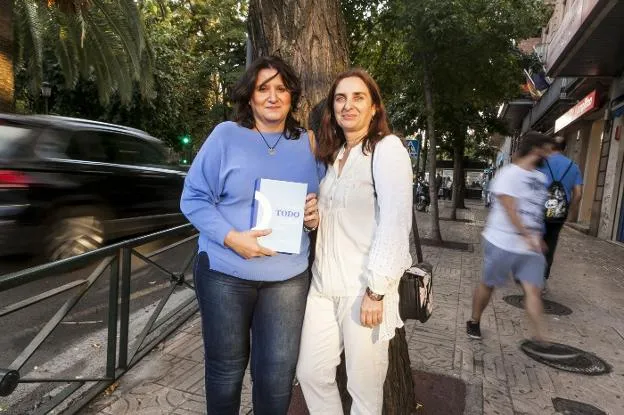Montserrat Parrales and Pilar Alcántara met in a room from the San Pedro de Alcántara hospital.It was on October 14, 2003. His daughters, aged 5 and 9 respectively, had just diagnosed type 1 diabetes, a disease that manifests mostly at an early age and originates when the pancreas does not produce insulin and the level ofBlood sugar is very high.At that time they had many doubts and great uncertainty.
Now, 14 years later, they wanted to tell their experience in the book entitled 'The day that everything changed', which also includes testimonies of other patients and family, in addition to the vision of 27 professions about this ailment.With this publication, above all, to give visibility to a disease that alters the routine of the one who suffers it and all those around.In the province it affects 1,300 people.
The book, of which a thousand copies have been published, was presented on September 23 at the Ágora Hotel.It is on sale for 20 euros at the Mirat gas station, in the Swindle of Camino Llano, at the headquarters of the Association of Diabetics of Cáceres and in Amazon, among other points of sale.Edited by EC Europe, the benefits achieved will be for the Oenegé Arco Iris Education for Development, which works on cooperation projects related to education and health in Africa and Latin America.
The phrases "Type 1 diabetes has nothing to do with that of grandparents or with the one originated by obesity" "My daughter told me that I was not able to climb the stairs;I was surprised that such a strong girl had so much fatigue "" has tried to normalize both the life of the diabetics that the disease has been silenced "
Why make a book about diabetes?Pilar, who is a teacher, has experience as a narrator.Write children's works."There came a time when I stated that there was something important to write about the issue of diabetes," he admits.And they got to work.They took the Svetlana writer Aleksiévich, Nobel Prize for Literature in 2015, and their choral narrative to give voice to invisible people."I thought that diabetes didn't have a voice," illustrates the teacher.«With diabetes we have a serious problem.Everyone talks about her thinking that she knows her.But it is that type 1 diabetes has nothing to do with that of grandparents or that originated by obesity or bad eating habits.It is totally different diabetes, ”says Montserrat.
They were clear that they wanted a plural book, with many voices.The result, after 20 months of intense work, is a copy with first person testimonies that allow the reader to know this reality closely.
"I realized that something was happening to my son because she was hit, she got angry, she cried a lot, she was very sad ... she was like a sick" hay "that is going to fall from the nest.It was constantly peppers ... I was two years old.But we really realized that something was happening because he started eating a lot and drank eight liters of water in two days, that is crazy, ”he says on page 28 Monti, mother of a 15 -year -old teenager from Robledillo de la Vera.
The alarms in the case of the authors of the publication were others.«I remember as if it were today my daughter's debut.It was an October 14, after the Puente del Pilar.Last Friday I talked to his pediatrician by phone, I told her the symptoms and told me that on Tuesday he took her to the health center to do a test.And to observe it ... months before I had already noticed small symptoms, which at all related to each other and that made me pass several times through the health center, but a Angela night, after having a glass of water almost from a drinkHe asked me another and there all the alarms jumped.At first I thought I was caughting attention, even theI scolded, ”recalls Montserrat.His daughter Angela is currently 19 years old.
In the case of Pilar the symptoms were different.Every time he remembers it, he confesses, he gets excited.«In my case my daughter said she was not able to climb the stairs.I was surprised that such a strong girl, with so much energy, had so much tiredness, ”he tells Triana, who is now 24 years old.An analytics confirmed the diagnosis.The most common symptoms of type 1 diabetes are quick weight loss, frequently urinating, having an extreme thirst and appetite or presenting weakness, fatigue or drowsiness, in addition to nausea and irritability.
After the diagnosis, a new routine loaded with habits came to which it costs time to get used to and a constant alert state due to blood glucose levels.For example, patients have to click on the finger eight times a day to control sugar and inject at least four times insulin.«Having diabetes implies having sugar above a normal level.The complicated thing is to keep it in place.It is not mathematical, thousands of factors influence.To start, you have to learn to count carbohydrates, ”says Montserrat.
The authors of the publication intend with this project to put on the table the day to day of these patients, which goes unnoticed for a large majority of society.«It has tried to normalize both the lives of people with diabetes to avoid the rejection that what has been achieved is to silence this disease.Many people live in silence.It is as if it did not exist, as if it were invisible.Instead of normalizing the issue, what has been done is that lack of respect for the needs of people with diabetes has been reached due to the misinformation and ignorance, ”argues Pilar Alcántara.
The book includes an epilogue where the authors reflect the needs detected in patients and within families.Among them is precisely to give more visibility to this ailment."Being chronic and dangerous, it remains, however, in silence, without being present in a society that remains oblivious to their needs," they write.They also consider that a greater "diabetological" education is needed, as well as the creation of diabetes units in hospitals and the implementation of a school protocol for acting in schools.«There is a need for a person to take care of students with diabetes during school hours.We observe that this is the point that causes the greatest problem of psychological stress and social discomfort in families, and must abandon, on many occasions, one of the members their work to be able to serve the son or daughter with diabetes during school hours, ”write theAuthors of the publication.
The project of these two women goes beyond the book.They have launched a documentary, directed by Juan Luis Rueda and entitled 'HEMOCIONES', where they reflect the philosophy of the publication.In addition, they have a blog and give informative talks to disseminate the disease their daughters suffer.On November 14, coinciding with World Diabetes Day, the exhibition entitled 'Do not hide your sweetness', which includes photos starring patients with type 1 diabetes, that disease that to Montserrat and PilarHe joined them in a hospital room and that they have determined to get out of the invisibility.



